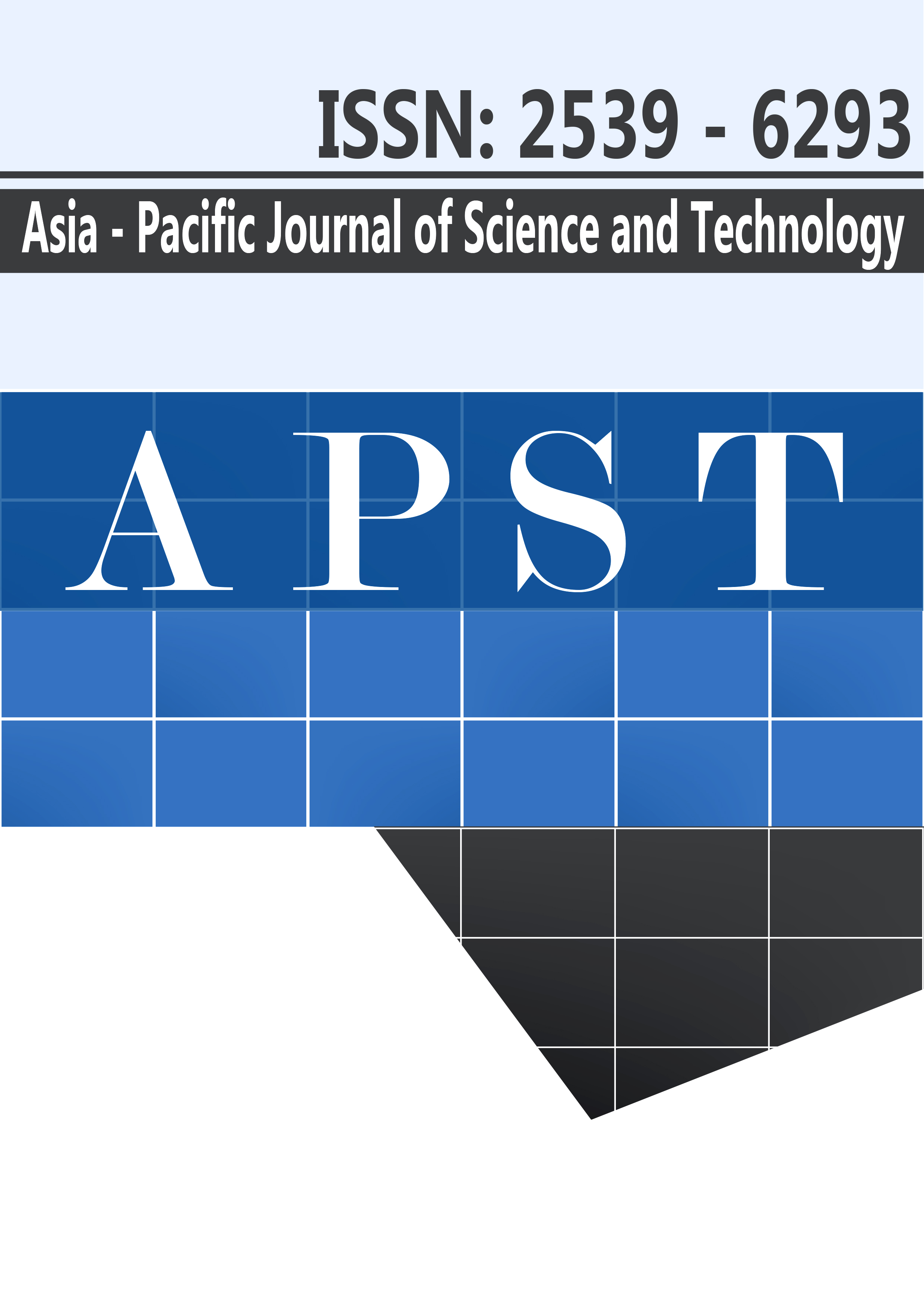The effects of garlic, banana, and onion as prebiotic supplementation on growth performances, feed utilization, and survival rate of Anabas testudineus
Main Article Content
Abstract
The aim of this research was to investigate the influences of local plants as prebiotic supplementary feeds on growth performances, feed utilization, and survival of climbing perch (Anabas testudineus). Economics of feeding in terms of the cost and return of climbing perch culture was also investigated. Three plants including garlic, banana, and onion at 20 g/kg feed were added to the feed and compared with a basal diet (control). The average initial weight of climbing perch was 5.47 – 5.51 g/fish. The research was carried out for 150 days. The results that showed there were no significant differences in the effects of chosen local plant supplementation on growth performances (p>0.05). However, fish fed with banana powder supplementation displayed significantly higher in feed utilization and survival rates (p<0.05) than other groups. The percentage of edible flesh was inversely proportional to protein in fish flesh. Results showed that control fish groups had the highest edible flesh (p<0.05) but lowest in protein in fish flesh. On the other hand, climbing perch fed with banana and onion feed additives had lower percentage of edible flesh, but higher percentages of protein in edible flesh. In summary, local plant additive feeds were not able to improve growth performances. However, a banana powder supplementary diet possibly enhances fish immunity and improves fish health leading to a higher survival rate which is able to provide a better return investment and higher protein in fish flesh.
Article Details
References
(1) Webster CD, Lim C,Tilapia: Biology, Culture, and Nutrition. Food product press, New York. USA. 2006.
(2) Reza A, Abdolmajid H, Abbas M, Abdolmohammad AK, Effect of Dietary Prebiotic Inulin on Growth Performance, Intestinal Microflora, Body Composition and Hematological Parameters of Juvenile Beluga, Husohuso (Linnaeus, 1758). Journal of the World Aquaculture Society. 2009; 40(6): 771–779.
(3) Ganguly S, Dora KC, Sarkar S, Chowdhury S, Supplementation of prebiotics in fish feed: a review. Rev Fish Biol Fisheries. 2013; 23(2):195-199.
(4) Gibson GR, Probert HM, Van Loo J, Rastall AR, Roberfroid M, Dietary modulation of the human colonic microbiota: updating the concept of prebiotics. Nutrition Research Reviewer. 2004; 17(02): 259 – 275.
(5) Halver JE, Hardy RW, (2002). Nutrient flow and retention. Fish nutrition. 2002; 3: 755-770.
(6) Horwitz W, Instructions for inserting: Official methods of analysis of AOAC International. AOAC international. 2002.
(7) Li P, Gatlin III DM, Dietary brewers yeast and the prebiotic GrobioticTM AE influence growth performance, immune responses and resistance of hybrid stripe bass (Morone chrysops X M. saxatilis) to Streptococcus iniae infection. Aquaculture. 2004; 231(1): 445 – 456.
(8) Olsen RE, Myklebust R, Kryvi H, Mayhew TM, Ringo E, Damaging effect of dietary inulin on intestinal enterocytes in Arctic charr (Salvelinus L.). Aquac Res. 2001; 32(11): 931 - 934.
(9) Pryor GS, Royes JB, Chapman FA, Miles RD, Mannanoligosaccharides in Fish Nutrition: Effects of Dietary Supplementation on Growth and Gastrointestinal Villi Structure in Gulf of Mexico Sturgeon. N Am J Aquac. 2003; 65(2): 106 – 111.
(10) Gence MA, Yilmaz E, Genc E, Aktas M, Effects of dietary
mannanoligosaccharide on growth, body composition and intestine and liver histology of the hybrid Tilapia (Oreochromis niloticus x O. aureus). Isr J Aquac. 2007; 59(3): 10 – 16.
(11) Yousefian M, Amiri MS, A review of the use of prebiotic in aquaculture for fish and shrimp. African Journal of Biotechnology. 2009; 8(25): 7313 -7318.
(12) Gatesoupe FJ, Probiotics and prebiotics for fish culture, at the parting of the ways. Aqua Feeds: Formulation & Beyond. 2005; 2(3): 3 – 5.
(13) Grisdale-Hellanda BS, Hellanda J, Gatlin III DM, The effects of dietary Supplementation with mannanoligosaccharide, fructooligosaccharide or galactooligosaccharide on the growth and feed utilization of Atlantic salmon (Salmo salar). Aquaculture. 2008; 283 (1): 163–167.
(14) Ganguly S, Prasad A, Microflora in fish digestive tract plays significant role in digestion and metabolism. Rev Fish Biol Fisheries. 2012; 22(1): 11 - 16.
(15) Tabrizi JM, Bbarzeghar A, Farzampour S, Mirzaii H, Sarfarmashaei S, Study of the effect of prebiotic (Saccharomyces cerevisiae) and acidifier on growth
parameters in grower' rainbow trout (Oncorhynchus mykiss). Annals of Biological Research. 2012; 3: 2053-2057.
(16) Yılmaz F, Ozdemir N, Demirak A, Tuna AL, Heavy metal levels in two fish species Leuciscus cephalus and Lepomis gibbosus. Food Chemistry. 2007; 100(2): 830-835.
(17) Gence MA, Aktas M, Genc E, Yilmaz E, Effects of dietary mannan oligosaccharide on growth, body composition and hepatopancreas histology of Penaeus semisulcatus (de Haan 1844). Aquacult Nutr. 2007; 13(2): 156-161.

